If you’ve been hearing about Industry 4.0 a lot lately, you’re not alone. This term is more than just a buzzword, and it has applications beyond its primary context of manufacturing. Here’s what marketers need to know about the Fourth Industrial Revolution.
What is Industry 4.0?
Each new industrial revolution has been about some big change in the way manufacturing is done. The first involved adding water and steam power, the second brought us the assembly line and the use of electricity in factories, and the third came about with the advent of computers and the internet.
Now, we’re at the beginning of another revolutionary change in which those computerized devices are becoming interconnected through the Internet of Things. Physical devices are now able to communicate with one another through the internet, exchange data in real time, and use cloud computing to make smarter recommendations. Over time, these devices can use the data they’ve stockpiled to recognize patterns and help make manufacturing more efficient than ever.
While it’s tempting to think of Industry 4.0 as the world being taken over by sentient robots, it’s not quite that sci-fi. Rather, the collaboration between humans and machines — and our ability to put the data they’re collecting to good use — is what it’s all about.
What Does Industry 4.0 Mean for Marketers?
I know that marketers are not manufacturers, but there are several principles we can take from Industry 4.0 and apply to our world to make our processes simpler — and our clients happier.
By investing the time and transitional resources necessary to update our operations and enable smarter processes, we stand to increase our output and efficiency, reduce expenses and waste, and free up time for innovation. Bonus: back-end efficiencies can often lead to higher consumer satisfaction.
Try these ways to put Industry 4.0 principles to work for you:
- Adopt an inbound approach. We now have the data to determine what our target customers are searching for and to draw them in organically with content that answers their questions. We can also use visitor behavior on our websites to identify where in the customer journey an individual is in order to deliver more personalized content. Inbound marketing is about letting the customer come to you when they’re ready to buy, and it not only saves you the time you spend on cold calls and emails, but it’s a better experience for your audience.
- Employ marketing automation software. Save time and energy by automating workflows. If you haven’t yet tried marketing automation software, think of it like turning your marketing communications into a machine that runs in the background while you’re getting other things done.
- Speak to the individual. Build trust and rapport with your audience by highly targeting your communications. Combine the data you have with the power of marketing automation and variable data printing, and you’ll have a head start in the client relationship department.
- Get into data science. You don’t have to go back to school, but learning the basics of predictive analytics and other forecasting and modeling techniques will help you identify your best prospects and how to meet their needs.
And if you’re an in-house marketer at a manufacturing organization that’s already taking advantage of Industry 4.0 and its benefits, make that part of your message! Let customers know how your company is doing things smarter and making things easier for them.
As our web of connectivity grows, marketing will continue to adapt and evolve. For now, we can be certain that Industry 4.0 is not the future — it’s the present.
Header photo by Aaron Barnaby



